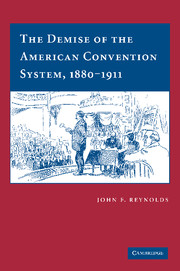Book contents
- Frontmatter
- Contents
- Acknowledgments
- Abbreviations
- The Demise of the American Convention System, 1880–1911
- 1 Introduction
- 2 The Search for Harmony: The Convention System in the Party Period
- 3 The Emergence of the Hustling Candidate
- 4 Coping with Competition: The Limitations of Party Self-Regulation
- 5 “The Pivot of Reform”: Debating the Direct Primary
- 6 The Direct Primary in the Reform Tradition
- Appendixes
- Bibliography
- Index
6 - The Direct Primary in the Reform Tradition
Published online by Cambridge University Press: 18 August 2009
- Frontmatter
- Contents
- Acknowledgments
- Abbreviations
- The Demise of the American Convention System, 1880–1911
- 1 Introduction
- 2 The Search for Harmony: The Convention System in the Party Period
- 3 The Emergence of the Hustling Candidate
- 4 Coping with Competition: The Limitations of Party Self-Regulation
- 5 “The Pivot of Reform”: Debating the Direct Primary
- 6 The Direct Primary in the Reform Tradition
- Appendixes
- Bibliography
- Index
Summary
Michigan's voters had never witnessed anything resembling Chase S. Osborn's barnstorming for the Republican gubernatorial nomination in 1910. Touring the lower peninsula in an automobile caravan over several weeks that summer, Osborn's entourage logged in twelve thousand miles – sometimes tooling along at an alarming thirty miles per hour. The “cow path campaigning” stopped “wherever we found a crossroads, a blacksmith shop and a bird's nest.” His savvy handlers sent an organizer to towns ahead to ensure that Osborn was greeted by a band and an enthusiastic crowd. Osborn was a “natural campaigner,” writes his biographer, “energetic, colorful, highly egotistical, a complete extrovert” and a good public speaker. Primary day left him hoarse from seven hundred mostly extemporaneous speeches. Osborn gloried in the glad-handing techniques perfected by candidates for lesser offices, but he did not overlook the tactics that had nominated governors past. He wrote numerous letters, hired a retinue of local campaign promoters, and even sought to enlist the census takers in his cause. It proved to be an expensive undertaking. Much of the thirty-five thousand dollars Osborn spent came out of his own bank account after his fellow mine owners proved less than generous. Some of the payments violated the state's new limitations on campaign expenditures, but it was easy enough to find loopholes in the statute. A longtime supporter of direct nominations, Osborn's ready adaptation to its demanding regimen accounted for his victory that fall.
- Type
- Chapter
- Information
- The Demise of the American Convention System, 1880–1911 , pp. 201 - 236Publisher: Cambridge University PressPrint publication year: 2006



